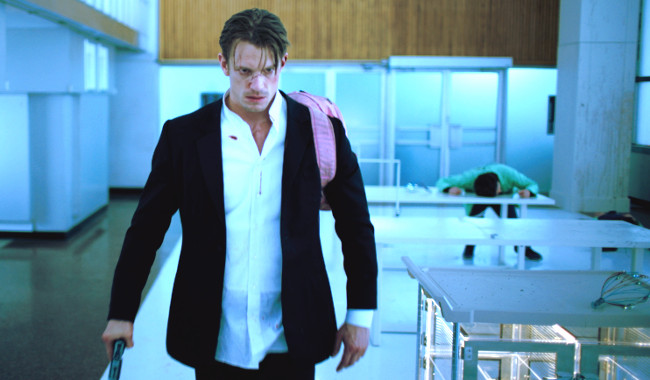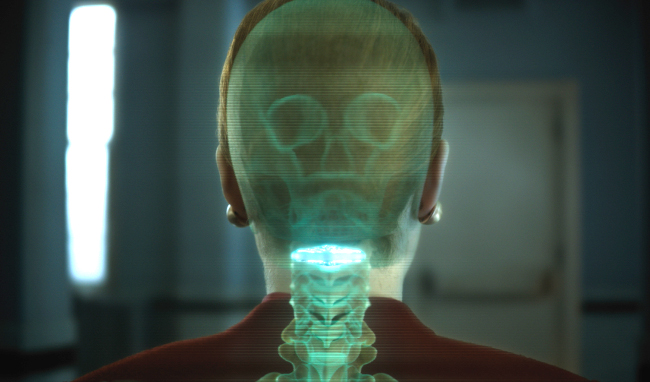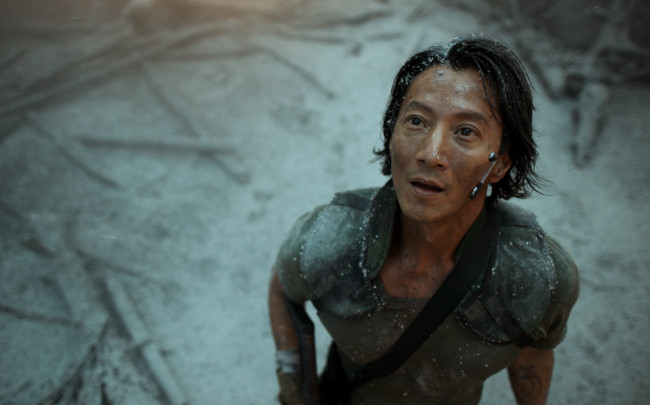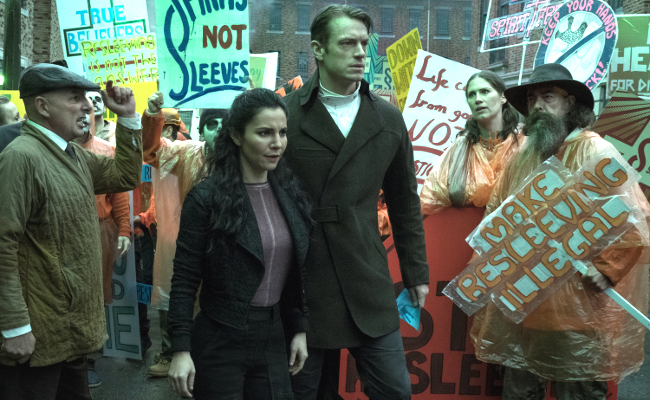
Laeta Kalogridis is best known for ambitious genre stories, whether it’s the twisting horror story of Shutter Island, which she scripted, or the upcoming, long-in-development Alita: Battle Angel. Today sees the debut of another long-in-the-works science fiction story, Altered Carbon, which Kalogridis shepherded into a series for Netflix.
Based on Richard K. Morgan’s 2002 novel (the first in a series), Altered Carbon follows Takeshi Kovacs, a former rebel who’s “resleeved” in another body after 250 years of having his mind kept in stasis. In this future, everyone’s consciousness is stored on a “stack,” a backup drive in the base of the neck, and can be “sleeved” into any body. And if you’re rich enough, death is an inconvenience. It’s a world where murder victims can be “spun up” to explain what happened, where minds can jump from body to body, and where suddenly almost nothing is for keeps. It can be grim, and also rather beautiful. Kalogridis, who serves as the show’s creator and wrote the pilot, sat down to discuss how such an ambitious show came together, and how it swings between extremes.

What first drew your attention to the novel?
I read it right after it came out. What drew me to it was the fascinating combination of noir plus the very different exploration of a very different kind of technology. People are focused on AI, but this is focused on transhumanism, and how it’d change the way we live. All that happened in the interim that it became more and more likely something like [the technology in the show] would exist. Half of Silicon Valley is working on digitizing consciousness in some way. I loved the style and the collision of these two and also what I regarded as the spectacular exploration of unintended consequences.
When did you get involved? The book’s been in the development cycle for quite a while.
It was about eight years ago. I actually need to pull the paperwork. [Laughs.] I want to say it was about 2011, and I knew that the option was not being renewed at Warners. I called Richard with a few of my partners and I pitched to him what I wanted to do. I knew that one of the problems at Warners was the attempt to make the story PG-13. That wasn’t an approach that I thought was going to bear fruit. I wanted to pitch to him to what I could do, because we couldn’t afford the size of the option Warners had done. This is an unapologetically hard-R and I would not be changing the plot.
What I didn’t know at the time, I mentioned that I was the sole breadwinner of my family and that this would take some time. I was just being honest, and it turned out later he had been going around the development cycle for long enough that [Morgan] preferred the honesty. That doesn’t usually work in my business! [Laughs.] That’s why we decided to make it a spec script for a feature.
So what led to the shift to a TV series?
We heard that it was so dense that we had to do too much exposition, and the rise of Peak TV gave us time to explore all the nooks and crannies, the core world because this technology affects every single thing in life. I went to Skydance, and they were very interested in making this a television show.

It’s an ambitious show in a lot of respects. Did you start out at that level when you were pitching it, or did you get a chance to scale it up?
I wrote it as I saw it, and then we sort of budgeted and scheduled. My instincts head towards getting excited about world-building, that has an immersive quality. Our pilot director, Miguel [Sapochnik] who set the look for the whole thing, shares that instinct to create an environment you can feel. And I think that’s what drove it, but we never really had a conversation about anything other than the show needed to be true to itself. So really the creative led. It’s one of the things I love about Netflix.
Were there any parts of the book you put back into the story once it became a series?
Absolutely! I was able to put back in Fight Drome. I had to take it out and it was really upsetting. Fight Drome gives you a launch into the Railene character. I was able to add the Lizzie storyline, and flesh out Ortega and her family. Ortega’s family is not really a part of a book, but you needed it once you were a longer form to understand her better.
You really explore a lot of those unintended consequences here, everything from religion to combat sports. How much work went into parceling it out and keeping audiences from feeling overwhelmed?
I ran a very traditional writers’ room, so we took every episode, we took cards, and we carded out every episode to see how the arcs came together. There are some complex things: when they die the first time, the second. In building out the world, there was a lot that Richard just had a sentence about, and I thought “That’s a whole episode by itself,” like the zero-g knife fights. A lot of it was just taking tiny pieces and building them out as part of the larger story, but doing it in within a traditional structure. One thing it did give me, I really love creating female characters in genre who have a lot of depth and strength, I had more room to explore those characters in those ten hours.

People don’t seem to value their bodies much in this future. Was that a deliberate theme or did it emerge from the material as you went through the show?
I think that when you are thematically dealing with the body becoming commodified, that consciousness no longer is housed in the body solely, but moves from body to body, one of the unfortunate side effects is the way the body is treated becomes very much the way you would treat an object. And in order to explore the disposability part, you need to deal with the human body in some of the brutal ways that we do. The worst physical violence is visited on Joel’s character, and we did that to drive home the conceptual idea that one of the uses of VR would be to be able to experience certain things that weren’t really happening, but your subjective experience would be that it had happened. I wasn’t sure how to achieve that without delving into the hard-R aspect. Noir has always been a hard-R genre for a reason because it’s talking about the dark sides of ourselves, I believe so we can do something about them.
Where are we heading from here? Do you plan to adapt the other books, or put your own spin on the ideas?
I think that the world itself is so huge! [Laughs.] I’m not sure what will happen if a Season two happens. I’m just hanging on for season one to come out. That’s the determining factor. I love the universe of Altered Carbon, and there are many more stories to be told.
All ten episodes of Altered Carbon begin streaming today on Netflix
